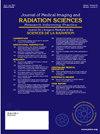3 种不同双能 CT 系统碘定量结果准确性的比较:一项模型研究
IF 1.3
Q3 RADIOLOGY, NUCLEAR MEDICINE & MEDICAL IMAGING
Journal of Medical Imaging and Radiation Sciences
Pub Date : 2024-10-01
DOI:10.1016/j.jmir.2024.101523
引用次数: 0
摘要
导言双能 CT 似乎在医学成像领域受到了极大的关注。特别是碘图,它已成为一种有价值的应用,可对整个图像中的造影剂浓度进行量化。CT 用户缺乏可靠的标准来评估各种 CT 系统生成的碘图的准确性。本研究旨在比较本医院最近采用不同发射技术的 3 种 CT 系统的碘定量性能。方法本研究使用了一个特定的自制模型,其中包含 12 种已知浓度的碘造影剂:从 0.4 到 50.0 毫克碘/毫升。测试了三台不同的双能量扫描仪:一台采用双源技术,两台配备了两个不同制造商生产的快速千伏-峰值切换解决方案。每个系统都按照特定的光谱采集协议进行了螺旋扫描。每个 CT 系统对每种浓度(毫克碘/毫升)进行八次采集,从而对每种浓度和 CT 进行 24 次测量。测量值的平均值与已知浓度进行比较,绝对定量误差(AQE)和相对百分比误差(RPE)用于比较每种 CT 的性能。高浓度(≥5.0 mgI/mL)时的定量更为精确。低浓度(<4.0 mgI/mL)测量值的准确性在不同设备之间存在很大差异。因此,在常规进行碘绘图之前,有必要对所有 CT 系统的性能进行全面评估。放射技师的职责是关注成像系统的性能,尤其是在处理碘定量等定量数据时。本文章由计算机程序翻译,如有差异,请以英文原文为准。
Comparison of iodine quantification results accuracy between 3 different dual-energy CT systems: a phantom study
Introduction
Dual-energy CT seems to be acquiring significant attention in the field of medical imaging. Iodine mapping, specifically, has emerged as a valuable application, enabling the quantification of contrast agent concentration throughout the images. CT users lack robust criteria to assess the accuracy of iodine maps generated by various CT systems. This study seeks to compare the performances of iodine quantification on 3 recent CT systems employing different emission-based technologies, positioned in our hospital.
Methods
A specific home-made phantom was used for this study, with 12 known concentrations of iodinated contrast agent: from 0.4 to 50.0 mgI/mL. Three different dual-energy scanners were tested: one employing dual-source technology and two systems equipped with Fast kilovolt-peak switching solution from two different manufacturers. Helical scans were performed for each system following specific spectral acquisition protocols. Eight acquisitions were performed for each concentration (mgI/mL) on each CT system, resulting in 24 measurements for each concentration and CT. Mean measured values were compared to the known concentrations, and the absolute quantification error (AQE) and the relative percentage error (RPE) were used to compare the performances of each CT.
Results
The obtained measurements' accuracy varied depending on the studied model but not on the acquisition mode. The quantification was more precise at high concentrations (≥5.0 mgI/mL). The accuracy of measured values at low concentrations (<4.0 mgI/mL) varied considerably from one device to another.
Conclusions
We identified variability in the results accuracy depending on the CT model, with sometimes significant deviation. Therefore, a comprehensive evaluation of the performances of all CT systems may be necessary before routinely conducting iodine mapping.
The radiographer role is to be attentive to the performances of imaging systems, especially when dealing with quantitative data such as iodine-quantification.
求助全文
通过发布文献求助,成功后即可免费获取论文全文。
去求助
来源期刊

Journal of Medical Imaging and Radiation Sciences
RADIOLOGY, NUCLEAR MEDICINE & MEDICAL IMAGING-
CiteScore
2.30
自引率
11.10%
发文量
231
审稿时长
53 days
期刊介绍:
Journal of Medical Imaging and Radiation Sciences is the official peer-reviewed journal of the Canadian Association of Medical Radiation Technologists. This journal is published four times a year and is circulated to approximately 11,000 medical radiation technologists, libraries and radiology departments throughout Canada, the United States and overseas. The Journal publishes articles on recent research, new technology and techniques, professional practices, technologists viewpoints as well as relevant book reviews.
 求助内容:
求助内容: 应助结果提醒方式:
应助结果提醒方式:


